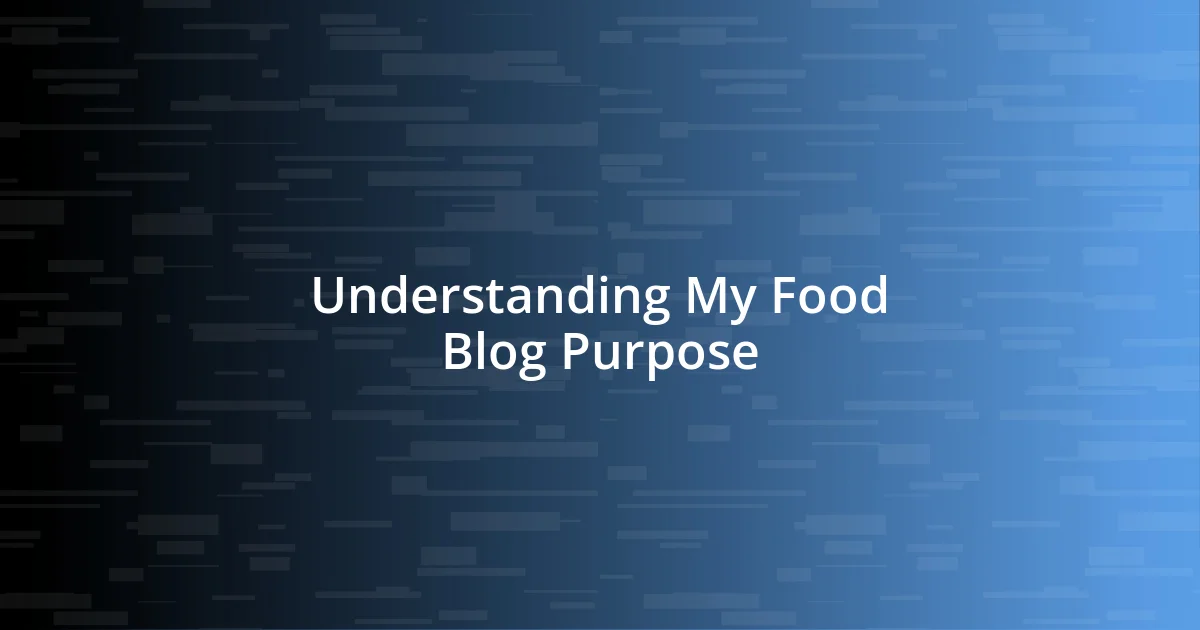Key takeaways:
- The purpose of the food blog evolved from merely sharing recipes to fostering connections and inspiring creativity in cooking among readers.
- Engaging with the audience’s preferences and demographics shaped the blog’s content strategy, leading to tailored recipes and increased community involvement.
- Effective promotion through social media, collaborations, and email marketing has been essential for growing the blog and maintaining reader engagement.

Understanding My Food Blog Purpose
Understanding the purpose of my food blog has been a journey in itself. Initially, I wanted to share recipes, but I soon realized it’s about connecting with others who share my passion for food. Isn’t it amazing how a simple dish can evoke memories and emotions?
As I navigated my blogging path, I discovered that my true aim was to inspire creativity in the kitchen. I remember when I shared a recipe for my grandmother’s famous apple pie; the flood of comments and stories from readers brought me so much joy. It’s moments like these that remind me I’m not just sharing food, but also experiences and culture.
Ultimately, my food blog serves as a platform for exploration and growth, not just for me but for my readers too. I often ask myself, “What do I want people to take away?” The answer keeps evolving, but it always revolves around the joy of cooking and the connections we make over shared meals. Isn’t that what life is really about?

Identifying Target Audience Preferences
To truly connect with my audience, I dive deep into their preferences and interests. I often think back to when I first started sharing vegan recipes; I noticed an enthusiastic response from readers seeking healthier options. This feedback guided me to explore more plant-based meals, as I realized that catering to their tastes not only enriched my content but also encouraged engagement.
Understanding the demographics of my audience has been a vital aspect of shaping my blog. I’ve found that younger readers tend to prefer quick, easy recipes, while seasoned home cooks are eager for more complex techniques. This realization sparked my idea to create a “30-Minute Dinner” series that resonates with busy individuals, making cooking feel accessible and enjoyable. It’s fascinating to witness engagement grow as I align my posts with their needs.
By continuously engaging with my audience through polls and comment sections, I feel more connected to them. I remember once asking what types of recipes they’d like to see next, and it was heartwarming to see their enthusiasm reflected in the responses. This back-and-forth communication significantly informs my content strategy, allowing me to curate posts that genuinely resonate with the readers, enhancing the sense of community that my blog aims to foster.
| Demographic | Preferred Content |
|---|---|
| Young Adults | Quick, Easy Recipes |
| Experienced Cooks | Complex Techniques |

Developing a Consistent Content Strategy
Developing a consistent content strategy is crucial for maintaining my blog’s identity and ensuring readers know what to expect. I’ve learned the hard way that posting sporadically led to confusion and a loss of engagement. Reflecting on my experience, I found that setting a regular posting schedule not only keeps me organized but also fosters a sense of anticipation among my audience. When I launched my “Meatless Monday” series, I noticed how readers began to look forward to these posts each week—it’s like a meal plan that they could rely on!
- Establish a clear posting schedule, such as weekly themes or monthly focuses.
- Maintain a balance between seasonal recipes and year-round favorites.
- Use analytics to track which types of posts resonate most with my audience.
- Stay flexible to adapt my strategy based on audience feedback or trending topics.
- Incorporate guest posts or collaborations to keep the content fresh and engaging.
I find it helpful to brainstorm content ideas in advance, which allows me to maintain a cohesive theme throughout the month. For instance, there was a time I batch-cooked a variety of soups and documented the process. It not only gave me rich content to share but also created a wonderful connection with readers as they shared their favorite soup recipes in the comments. It’s those shared experiences that transform my blog into a vibrant community, and that’s what I aim to nurture.

Sourcing Fresh and Local Ingredients
When it comes to sourcing fresh and local ingredients, I always believe that the quality of the produce shines through in my recipes. I often visit farmers’ markets in my area, and let me tell you, the vibrant colors and rich scents are simply intoxicating. Just last week, I stumbled upon a stall selling heirloom tomatoes, and their taste was nothing like the supermarket ones. Have you ever tasted a tomato that actually bursts with flavor? It’s a game changer for any dish.
Building relationships with local farmers has been a game changer for my blog. I remember the first time I chatted with a farmer about his growing practices. He shared fascinating insights into sustainable agriculture, which inspired me to include those stories in my posts. Those personal touches create a deeper connection with my audience, as I can confidently share where my ingredients come from and the passion behind them. It makes my content not only informative but also a taste of the local culture.
I find that cooking with local, seasonal ingredients brings a sense of excitement to my kitchen. Each week, I try to adapt my recipes based on what’s available. For example, when asparagus is in season, I often whip up a creamy risotto, savoring every bite knowing it’s fresh from just down the road. It’s that fresh taste combined with the knowledge that I’m supporting local farmers that keeps my creative juices flowing. How does sourcing local ingredients shape your experience in the kitchen?

Crafting Engaging Food Photography
Crafting engaging food photography is essential for drawing readers into the stories behind my recipes. I remember my early days of food blogging when my photos often fell flat, failing to capture the vibrancy of the dishes I created. It took some trial and error, but I found that natural light is my best friend. On a bright sunny day, I often place my dishes near a window. The way sunlight dances off the food creates a mouthwatering allure that even the most boring meal can’t resist. Could you imagine a bowl of pasta illuminated just right, making the sauce glisten?
Backdrops play a vital role in setting the mood, too. I’ve experimented with various styles over the years, from rustic wooden tables to simple white linens. One afternoon, while searching for the perfect backdrop, I noticed a lovely piece of slate in my garden. It transformed a simple salad into a gourmet presentation that received rave reviews online! I realized how much a subtle change in the background can enhance the appeal of the dish, sparking curiosity and inviting viewers to take a closer look. What do you think makes a photo truly stand out?
Finally, I find that engaging food photos tell a story. In one recent post, I decided to showcase the step-by-step process of making homemade bread. I snapped shots of my hands kneading the dough, capturing the texture and the emotion of the moment. Readers commented on how they felt they were part of the baking journey, and that connection is what I cherish the most. It’s amazing how a single image can convey a wealth of experience and emotion, making viewers feel like they’re right there in the kitchen with me. What stories do your food photos tell?

Writing Compelling and Informative Recipes
Writing recipes that are both compelling and informative is a fascinating journey. I’ve learned that a good recipe is like a good story; it needs a hook. One time, while experimenting with a twist on classic chili, I opened with a vivid description of the warm spices filling my kitchen, instantly pulling readers into the experience. Isn’t it amazing how just a few descriptive words can ignite a sense of taste?
Clarity is also paramount in my recipes. I remember the frustration of encountering a recipe filled with vague measurements and terms like “a pinch” or “to taste.” So, I make it a point to be precise. If a dish calls for a tablespoon of olive oil, I say exactly that. Readers appreciate straightforward instructions and can follow along with confidence. Have you ever tried to recreate a dish only to be thwarted by unclear directions? Trust me, I’ve been there, and it’s disheartening!
Incorporating personal stories enhances the recipe further. Last summer, my family and I had a lovely picnic, and I created a vibrant quinoa salad packed with vegetables from our garden. I shared how each ingredient held significance—like that sweet pepper my daughter picked herself. When readers see the heart and history behind a dish, it transforms a simple collection of instructions into a memorable culinary adventure. What moments do you share that make your recipes unique?

Promoting My Blog for Growth
Promoting my blog for growth involves a mix of creativity and strategy that I find both challenging and exciting. One method I’ve embraced is leveraging social media platforms in a way that feels personal rather than promotional. For instance, posting behind-the-scenes moments of my cooking process not only builds a connection with my audience but also encourages them to share their thoughts and creations, creating a vibrant community around my blog. Have you ever received unexpected feedback that changed your perspective? I certainly have, and it’s those interactions that inspire me to keep improving.
Another vital aspect of promotion is collaboration with other bloggers and influencers. A few months ago, I partnered with a fellow food blogger for a recipe swap, and it opened my eyes to new audiences. We shared each other’s recipes on our platforms, and the response was heartwarming. I loved seeing how our combined efforts brought together fans of both blogs, sparking conversations and interactions that strengthened our communities. Isn’t it incredible how teamwork can amplify our voices?
Email marketing has also proven to be a game-changer for my blog’s growth. Sending out a monthly newsletter with curated recipes and personal stories has allowed me to maintain a direct line of communication with my readers. I often include a small section called “Recipe of the Month,” where I share insights and excitement about a dish that resonated with me recently, like the fragrant saffron risotto I played with last week. It’s about making that personal connection—don’t you think that’s key to keeping our readers engaged?














